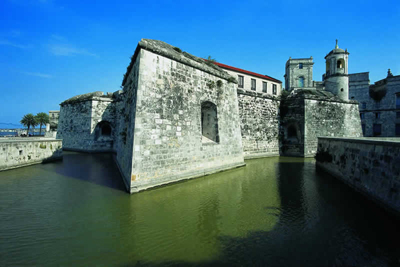Sistema Informativo Multidimensionale
El Sistema de Fortificaciones
- I castelli
Castillo de Santo Domingo de Atarés
Castillo De Santa Dorotea de Luna de la Chorrera
Castillo Hornabeque de San Diego O Fuerte
Castillo de la Cabana
Castillo de San Salvador de la Punta
Castillo de Los Tres Reyes del Morro
Castillo de El Príncipe
Castillo Fuerte de Cojímar
Torreon de SanLazaro
Torreòn de Bacuranao
Batterie
Torreón de San Dionisio de Jaruco
Polvorín de San Antonio
Muraglie
Castillo de la Fuerza
Castillo de San Salvador de La Punta
Ciudad vieja de La Habana y su sistema de Fortificaciones
Fundada en 1519 por los españoles, La Habana se convirtió en el siglo XVII en un importante astillero para la región del Caribe. Aunque hoy es una metrópoli tentacular con dos millones de habitantes, su antiguo centro conserva una interesante mezcla de monumentos barrocos y neoclásicos, así como un conjunto homogéneo de casas con arcadas, balcones, rejas de hierro forjado y patios interiores.
Source: UNESCO/ERI




Havana, last of the cities founded in Cuba by the Spanish conquistadores, had become by 1550 the most important on the island, a position that it has continued to hold. Havana was established at its present location in 1519 by the Spanish and became one of the Caribbean's main centres for shipbuilding. Its location made of the city a perfect gathering point for the annual treasure fleets bound for Spain from Mexico and Peru: Havana became the front door to the vast Spanish colonial empire, and in 1607 it became also the capital of Cuba.
In 1762, during the Seven Years' War, England seized Havana and held on to it for 11 months, then exchanging it for Florida. Newly recovered Havana was then turned into a strongly fortified city; it was also allowed to trade freely, developing and growing steadily through the 18th and 19th centuries. The city was physically untouched by the devastating wars of independence in the second half of the 18th century, making Havana easily the finest surviving Spanish complex in the Americas.
During Prohibition in the United States, Havana became a paradise for those who wanted good rum and fine cigars - at least until New Year's Eve 1959, when rebels led by Fidel Castro marched into town. Today it is a capital of about 2 million inhabitants, the largest city in the Antilles and, with its skyscraper district dominating the port, the most modern. [a bit of repetition - which to delete?]
Despite its turbulent history, the city suffered little damage in the country's wars and revolutions, and stands today much as it was built 100 years ago or more. It is today a sprawling metropolis of 2 million inhabitants, its old centre retaining an interesting mix of Baroque and neoclassical monuments, and a homogeneous ensemble of private houses with arcades, balconies, wrought-iron gates and internal courtyards.
Many of Old Havana's finest buildings have been converted into museums, and there are churches, palaces, castles, revolutionary monuments and markets to visit; however, the renovations are only slowly extending to residential areas. The most outstanding sights include the Plaza de la Catedral, one of the most beautiful squares in the city, with the towers of the Catedral de San Cristóbal de La Habana which dominate the square. Nearby is the Castillo de la Real Fuerza, the oldest extant colonial fortress in the Americas: its west tower is crowned by a bronze weathervane dating back to 1632. La Giraldilla, as the nimble-figured wind-spinner is called, is believed to be Doña Inés de Bobadilla, waiting in vain for her husband, the explorer Hernando de Soto, who set off to Florida looking for the Fountain of Youth and died eaten by cannibals.
The royal palm-studded Plaza de Armas has been the seat of authority and power in Cuba for 400 years. The imposing Palacio de los Capitanes Generales on the west side of the square is one of Cuba's most majestic buildings: it is now the City Museum. Calle Obispo runs off the Plaza de Armas and was one of Ernest Hemingway's hangouts.
For the last several years the government of Cuba has been involved in efforts to restore to the historic centre its character of a colonial city, which has been compromised by a rapid urbanization. The fortress of La Fuerza has been restored, as have the palaces of the Segundo Cabo and of Los Capitanes Generales. The pattern of early urban setting still exists with its four large squares: Plaza de La Cathedral, Plaza de San Francisco, Plaza Vieja and Plaza de Las Armas. There is also a notable complex of 17th- to 19th-century buildings.
Source: UNESCO/CLT/WHC


